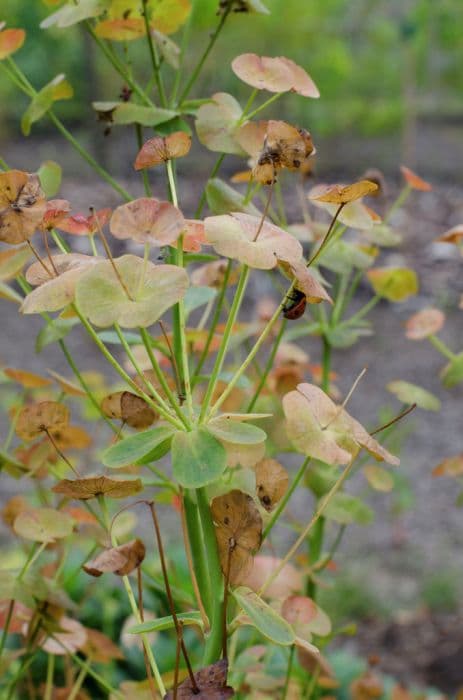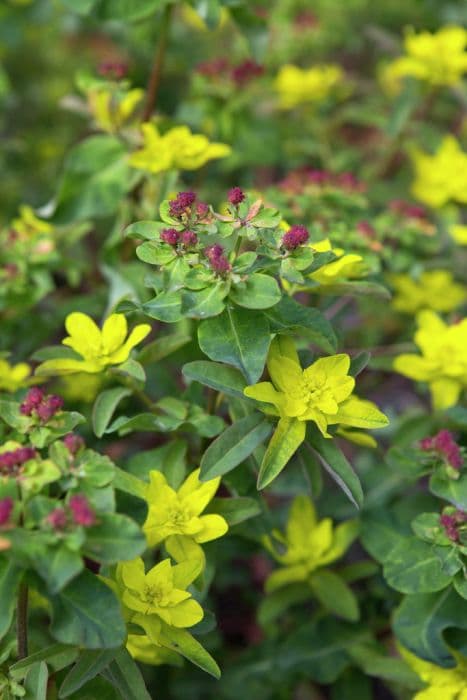Euphorbia characias subsp. characias 'Burrow Silver' (v)

ABOUT
Euphorbia characias subsp. characias 'Burrow Silver' (v), commonly known as Spurge, is a striking and architectural evergreen perennial. It has a distinctive growth habit, featuring dense, dome-shaped mounds festooned with upright, cylindrical stems. These stems are cloaked in narrow, silver-blue leaves that give the plant a frosty, shimmering appearance. In spring and early summer, the plant produces clusters of small, vibrant green flowers which are actually bracts, nestled at the tip of each stem. These bracts can have a touch of yellow or chartreuse, adding to the plant's eye-catching display. The combination of its silvery foliage and contrasting flowers make Spurge a statement piece in any garden, providing both texture and color year-round.
About this plant
 Names
NamesFamily
Euphorbiaceae.
Synonyms
Mediterranean Spurge, Albanian Spurge.
Common names
Euphorbia characias subsp. characias 'Burrow Silver' (v)
 Toxicity
ToxicityTo humans
The Mediterranean Spurge is considered toxic to humans. The plant contains a milky sap that is irritating to the skin and mucous membranes. If ingested, the sap can cause severe pain in the mouth and throat, swelling, difficulty swallowing, and gastrointestinal upset including vomiting and diarrhea. In severe cases, contact with the eyes can lead to temporary or permanent blindness. Care should be taken to avoid contact with the sap, and if exposure occurs, the area should be washed immediately with water and medical advice sought.
To pets
The Mediterranean Spurge is toxic to pets. Similar to its effects on humans, the milky sap within the plant can cause irritation to the skin and mucous membranes of animals. If ingested, the plant can cause symptoms of toxicity such as drooling, vomiting, diarrhea, and possibly difficulty breathing if the throat swells. If the sap comes into contact with your pet's eyes, it can cause serious eye irritations and potentially blindness. Pet owners should prevent animals from having any contact with the plant, and if exposure occurs, they should wash the affected area with water immediately and consult a veterinarian.
 Characteristics
CharacteristicsLife cycle
Perennials
Foliage type
Evergreen
Color of leaves
Silver
Flower color
Yellow-green
Height
3-4 feet (91-122 cm)
Spread
3 feet (91 cm)
Plant type
Shrub
Hardiness zones
7
Native area
Mediterranean
Benefits
 General Benefits
General Benefits- Ornamental Appeal: Euphorbia characias 'Burrow Silver' adds aesthetic value to gardens with its striking silver-blue foliage and architectural form.
- Drought Tolerance: Once established, it is very drought-resistant, making it suitable for dry or xeriscape gardens.
- Low Maintenance: It requires minimal care once established, making it ideal for gardeners seeking low-maintenance plants.
- Long Blooming: This plant has a long blooming period, producing chartreuse flowers that add color to gardens for many months.
- Pest Resistance: Euphorbia characias 'Burrow Silver' is generally resistant to pests and diseases, reducing the need for chemical treatments.
- Attracts Pollinators: Its flowers can attract pollinators such as bees, which are beneficial for the garden ecosystem.
- Versatility: It can be used in various garden designs, including Mediterranean, rock, and coastal gardens.
- Deer Resistance: Euphorbia is not favored by deer, making it a good choice for gardens in areas where deer are a problem.
- Evergreen: Being an evergreen plant, it provides year-round interest and structure to the garden.
- Soil Adaptability: Although it prefers well-drained soil, it can adapt to a variety of soil types.
 Medical Properties
Medical PropertiesThis plant is not used for medical purposes.
 Air-purifying Qualities
Air-purifying QualitiesThis plant is not specifically known for air purifying qualities.
 Other Uses
Other Uses- Photography and Art Subjects: Euphorbia characias 'Burrow Silver' is often used by photographers and artists for its sculptural qualities and striking silvery-blue foliage, making it a distinctive subject in gardens and nature-inspired art pieces.
- Dye Production: The milky sap of the plant has been historically used to produce a natural dye for fabrics, although this use requires careful handling due to the sap’s irritating properties.
- Educational Tool: Gardeners and educators may use Euphorbia characias 'Burrow Silver' to teach about plant defense mechanisms, as its sap is a deterrent to herbivores and its structure is adapted to dry climates.
- Insectary Plant: This euphorbia can serve as a host plant for certain species of insects, thus supporting biodiversity by providing a habitat and food source within a garden ecosystem.
- Soil Erosion Control: Because of its dense and extensive root system, the plant can be used in landscaping to help stabilize soil and prevent erosion on slopes.
- Landscape Design: With its distinctive foliage and structure, it's used for creating contrast and focal points in xeriscapes and Mediterranean gardens.
- Cultural Ceremonies: In some cultures, the distinctive look of the Euphorbia characias 'Burrow Silver' might have a role in traditional ceremonies or decoration due to its unique aesthetic.
- Tanning Leather: The tannins present in some parts of the plant have been used in the tanning process of leathers, though this is not a common use due to the plant's potential toxicity.
- Green Roofs: This drought-resistant plant can be used on green roofs where low water-use plants are needed to create sustainable urban landscapes without heavy maintenance.
- Frost Indicator: Due to its sensitivity to extreme cold, some gardeners observe Euphorbia characias 'Burrow Silver' as an indicator plant to determine if temperatures are low enough to cause damage to more sensitive species.
Interesting Facts
 Feng Shui
Feng ShuiThe Mediterranean Spurge is not used in Feng Shui practice.
 Zodiac Sign Compitability
Zodiac Sign CompitabilityThe Mediterranean Spurge is not used in astrology practice.
 Plant Symbolism
Plant Symbolism- Resilience: Euphorbia characias subsp. characias 'Burrow Silver', commonly known as Mediterranean Spurge, features a tough, drought-resistant nature, symbolizing a creature's ability to endure and thrive in challenging conditions.
- Protection: With its toxic sap and spiny appearance, the Mediterranean Spurge represents defense and the necessity of setting boundaries to protect oneself from harm.
- Uniqueness: The distinct foliage and growth habit of the Mediterranean Spurge symbolize celebrating individuality and embracing one's unique traits.
- Purification: In some cultures, spurge plants are associated with cleansing, and the 'Burrow Silver' variety carries this symbolism of purging negativity or bad energy.
 Water
WaterMediterranean Spurge should be watered when the top inch of soil feels dry to the touch, which typically equates to once every 7 to 10 days during the active growing season in spring and summer. In the winter, when the plant is dormant, reduce watering frequency to once every 2 to 3 weeks. Use room temperature water and ensure thorough saturation of the soil, allowing excess water to drain away. An established plant may require about 1 gallon of water per watering session, depending on the size of the container and the environmental conditions.
 Light
LightMediterranean Spurge thrives in full sun but can tolerate partial shade. It performs best when placed in a location where it receives at least 6 hours of direct sunlight daily. Avoid deep shade as it may lead to leggy growth and fewer blooms.
 Temperature
TemperatureMediterranean Spurge can tolerate a wide temperature range but performs best between 50°F and 80°F. The plant can withstand temperatures as low as 30°F but should be protected from frost, and it can cope with high temperatures around 100°F as long as it's not exposed to intense afternoon sun.
 Pruning
PruningPrune Mediterranean Spurge after flowering to maintain its shape and encourage fresh growth. This typically means cutting back the flowered stems by one-third in late summer or early fall. Pruning should be done annually, and always wear gloves to protect against the plant's sap, which can be an irritant.
 Cleaning
CleaningAs needed
 Soil
SoilThe Mediterranean Spurge ('Burrow Silver') thrives in well-draining soil with a mixture of two parts loam, one part sand or perlite, and one part peat or compost to retain some moisture while ensuring good drainage. The ideal soil pH for this plant ranges from slightly acidic to neutral, around 6.0 to 7.5.
 Repotting
RepottingMediterranean Spurge ('Burrow Silver') should be repotted every two to three years. Since it's a slow-growing plant, frequent repotting is unnecessary unless the soil becomes compacted or the plant outgrows its current container.
 Humidity & Misting
Humidity & MistingMediterranean Spurge ('Burrow Silver') is tolerant of a wide range of humidity levels, but it does best in dry to average humidity conditions typical of Mediterranean climates. It does not require high humidity and can withstand drier air.
 Suitable locations
Suitable locationsIndoor
Provide bright light, low humidity, and infrequent watering.
Outdoor
Plant in full sun, well-drained soil, protect from cold winds.
Hardiness zone
8-11 USDA
 Life cycle
Life cycleEuphorbia characias subsp. characias 'Burrow Silver' (v), commonly known as Mediterranean Spurge, begins its life cycle as a seed, which germinates in favorable conditions—typically in warm soil with good drainage and adequate sunlight. Upon germination, the seedling establishes a root system and sends up shoots, eventually forming a rosette of silver-blue foliage as a juvenile plant. As it matures, Mediterranean Spurge develops a woody base and upright stems, and its characteristic foliage becomes more pronounced, with leaves arranged in spirals around the stems. In late winter to early spring, the plant reaches the flowering stage, with distinctive greenish-yellow flowers that arise from the upper leaf bracts, providing ornamental interest. After pollination and seed set, the plant may enter a period of dormancy, especially in hotter climates, to conserve energy. Over time, Mediterranean Spurge completes its life cycle by dying back and may self-seed, allowing new plants to emerge and continue the species' presence in the garden.
 Propogation
PropogationPropogation time
Spring-Early Summer
Propogation: The Mediterranean spurge, a variant specifically known as 'Burrow Silver', can be propagated predominantly by seed or by taking cuttings. The most popular method involves taking cuttings, which is typically done in late spring or early summer when the plant is actively growing. To propagate by cuttings, one would select a healthy, non-flowering stem and cut a piece about 3 to 5 inches (approximately 7.6 to 12.7 centimeters) long. The cut end should be dipped in water immediately to stop the milky sap from flowing out, as it can be an irritant. After letting the cutting dry for a day to form a callus over the wound, it is then placed in a well-draining soil mix or sand. The cutting should be kept warm, around 70°F (about 21°C), with moderate light until roots have developed, which usually takes a few weeks. After rooting, the plant can be transplanted into a more permanent location.


![Spurge [Silver Swan]](/_next/image?url=https%3A%2F%2Fplants-admin.emdemapps.com%2Fimages%2Fplants%2F%2Fimages%2F604b573f6c8f6.png&w=640&q=75)






